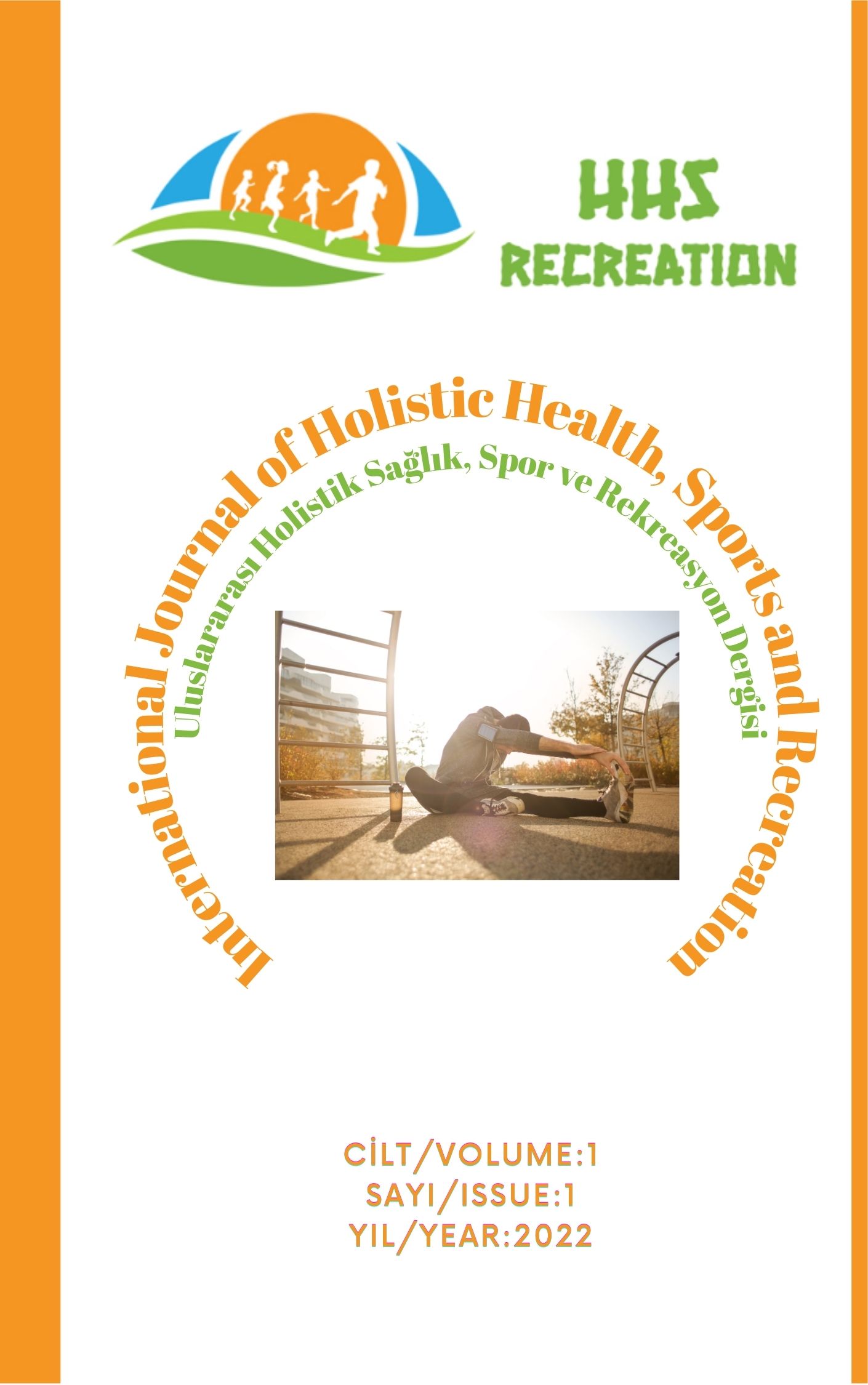Ekstrem Sporu Yapan Bireylerin Risk Alma ve Yaşam Kalitesi Düzeylerinin İncelenmesi
DOI:
https://doi.org/10.5281/zenodo.7487688Anahtar Kelimeler:
Ekstrem sporlar, risk alma, yaşam kalitesiÖzet
Bu çalışmanın amacı, farklı ekstrem sporuyla uğraşan bireylerin risk alma ve yaşam kalitesi düzeylerinin farklı değişkenlere göre incelenmesidir. Çalışmanın grubunu Doğu Anadolu bölgesinde en az bir kez yarışma deneyimi olan 156’sı (%89.1) erkek, 19’u (%10.9) kadın toplam 175 katılımcı oluşturmaktadır. Veri Toplama aracı olarak, araştırmacılar tarafından oluşturulan kişisel bilgi formu (yaş, cinsiyet, spor yapma yılı, çocuk sayısı, sporu hangi amaçla yapıyorsunuz), kişilerde risk alma davranışlarını ölçmek için ilk olarak ilk olarak Weber ve diğ. (2002) tarafından geliştirilen, Blais ve Weber (2006) tarafından kısa formu oluşturulan Türkçe geçerlik ve güvenirlik çalışması Dinç ve Tez (2019) tarafından hazırlanmış olan, alt boyutlarında etik, sosyal, sağlık/güvenlik, rekreasyon ve finansal alanları içeren “DOSPERT (A-Domain-SpecificRisk Taking) ölçeği ile DSÖ tarafından geliştirilen geçerlik ve güvenirliği Eser ve diğerleri (1999) tarafından yapılan genel bedensel, psikolojik, sosyal, çevresel alt boyutlarından oluşan “Dünya Sağlık Örgütü Yaşam Kalitesi Ölçeği-Kısa Formu Türkçe Versiyonu” kullanılmıştır. Verilerin analizinde normallik testi yapılmış verilerin normal dağılım göstermediği görüldüğünden non-parametrik testlerden ikili karşılaştırmalar için Mann Whitney-U testi ile ikiden fazla karşılaştırmalar için Kruskal Wallis H testi kullanılmıştır. Araştırma sonuçlarında cinsiyet ve sporu hangi amaçla yapıyorsunuz değişkenlerine göre risk alma ve yaşam kalitesi alt boyutlarında anlamlı farklılık görülmemiştir(P>0.05). Yaş değişkenine göre risk alma alt boyutlarından sosyal ve finansal 18-30 yaş lehine anlamlı farklılık görülmüştür (p<0.05). Sporun yapıldığı yılla göre yaşam kalitesi alt boyutlarından bedensel, sosyal ve çevreselde 4-6 yıl yapanlar lehine anlamlı farklılık görülmüştür (P<0.05). Çocuk sayısına göre ise risk alma alt boyutlarından sosyal, finansal ve rekreasyonda çocuğu olmayanlar lehine anlamlı farklılık görülmüştür (P<0.05). Sonuç olarak, Ekstrem spor yapanların spor yapma yıllı ve yaşı arttıkça yaşam kalitelerinde artma olduğu, risk almada ise düşüş olduğu söylenebilir.
Referanslar
Blais, AR, ve Weber, EU. (2002). Testing invariance in risk taking: a comparison between anglophone and francophone groups, Scientific Series, 25, 1-28.
Blais, AR, ve Weber, EU. (2006). A Domain-Specific Risk-Taking (DOSPERT) scale for adult populations. Judgment and decision making, 1, 33-47.
Demirhan, G., AŞÇI, F. H., Kangalgil, M., ve Saraçbaşı, O. (2014). Perception of Risk and Attractiveness of Extreme Sports Among Turkish University Students. Spor Bilimleri Dergisi, 25(1), 11-22.
Dinç. S.C., ve Tez, Ö.Y. (2019). Alana Özgü Risk Alma Ölçeği- Kısa Formu’nun (DOSPERT-30) Türkçe Uyarlaması, Spor Bilimleri Dergisi / Hacettepe Journal of Sport Sciences, 30 (3), 107-120
Dinç. S.C., ve Tez, Ö.Y. (2021). Macera Rekreasyonu Katılımcılarının Risk Alma Davranışlarında Farklılık Yaratan Değişkenlerin İncelenmesi, Int J Sport, Exer & Train Sci, Vol 7(4), 203–219
Eser, E., Fidaner, H., Fidaner, C., Eser, S. Y., Elbi, H., ve Göker, E. (1999). WHOQOL-100 ve WHOQOL-BREF'in psikometrik özellikleri [The psychometric properties of WHOQOL-100 and WHOQOL-BREF]. Psikiyatri Psikoloji Psikofarmakoloji (3P) Dergisi, 7(2), 23-40.
Immonen, T., Brymer, E., Orth, D., Davids, K., Feletti, F., Liukkonen, J., & Jaakkola T. (2017). Understanding action and adventure sports participation-an ecological dynamics perspective. Sports Medicine-Open, 3(18), 1-7.
Karasar, N. (1994). Bilimsel araştırma yöntemi: Kavramlar, ilkeler, teknikler. Anı Yayıncılık.
McVeigh, S.A., Hitzig, S.L. & Craven, B.C. (2009). Influence of sport participation on community integration and quality of life: A Comparison between sport participants and non-sport participants with spinal cord injury. J Spinal Cord Med., 32(2),115-124.
Moore, S., & Gullone, E. (1996). Predicting adolescent riskbehavior using a personalized cost-benefit analysis. Journal of Youth andAdolescence, 25(11), 343-359.
Skevington, S.M., Loftly M. & O’Connell K.A. (2003). The World Health Organization’s Whoqol-Bref Quality of Life Assesment: Psychometric properties and results of the international field trial a report from The WHOQOL Group. Quality of Life Research 13, 299-310.
The Spine in Extreme Sports By Kenneth P Burres MD. (2009). [homepage on the Internet]. [Updated: March 03 2009] Available from: www.fitcentric.com/ download/Spine %20in%20Extrm%20 Sports_10_03.pdf Aktaran: Şimşek.K.Y. (2010). Dünya Spor Endüstrisinde Ekstrem Sporların Gelişimi ve Yeri, BESBD 2010;5(1). 21-27.
İndir
Yayınlanmış
Nasıl Atıf Yapılır
Sayı
Bölüm
Lisans
Telif Hakkı (c) 2022 Uluslararası Holistik Sağlık, Spor ve Rekreasyon Dergisi

Bu çalışma Creative Commons Attribution 4.0 International License ile lisanslanmıştır.



